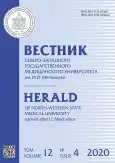Антибактериальная терапия эндометрита после кесарева сечения: оптимизация режима дозирования
- Авторы: Коробков Н.А.1, Бакулина Н.В.1, Репина М.А.1
-
Учреждения:
- Федеральное государственное бюджетное образовательное учреждение высшего образования «Северо‑Западный государственный медицинский университет имени И.И. Мечникова» Министерства здравоохранения Российской Федерации
- Выпуск: Том 12, № 4 (2020)
- Страницы: 67-72
- Раздел: Оригинальные исследования
- URL: https://journals.rcsi.science/vszgmu/article/view/50864
- DOI: https://doi.org/10.17816/mechnikov50864
- ID: 50864
Цитировать
Аннотация
Цель — изучить фармакокинетику β-лактамных антибиотиков при развитии эндометрита после кесарева сечения для выбора оптимального режима их дозирования.
Методы. В проспективное рандомизированное одноцентровое исследование были включены 52 родильницы с эндометритом после кесарева сечения, разделенные на четыре группы. Пациентки первой группы (n = 17) получали курс цефтриаксона болюсно в дозе 2,0 г однократно (n = 10) и в режиме продленной периоперационной инфузии (n = 7); пациентки второй группы (n = 10) — цефепим болюсно в дозе 2,0 г 2 раза в сутки (n = 5) и в режиме продленной инфузии (n = 5); пациентки третьей группы (n = 14) — амоксициллин/клавулановая кислота (Амоксиклав® 1000 мг + 200 мг) болюсно в дозе 1,0 г 3 раза в сутки (n = 7) и в режиме продленной инфузии (n = 7); пациентки четвертой группы (n = 11) — ампициллин/сульбактам (Амписид® 1000 мг + 500 мг) болюсно в дозе 1,0 г 4 раза в сутки (n = 6) и в режиме продленной инфузии (n = 5). Проведено сравнение концентрации исследуемых антибиотиков в полости матки в четырех группах методом высокоэффективной жидкостной хроматографии.
Основные результаты. Эффективная бактерицидная концентрация (С > 4×МПК) не сохранялась на протяжении всего междозового интервала ни в одной из групп лечения. Клиническая эффективность и безопасность исследуемых режимов введения антибиотиков была сходной. Однако продленная инфузия цефепима и аминопенициллинов обеспечивала их значимо более высокие концентрации в лохиях.
Заключение. Продленная внутривенная инфузия цефепима, цефтриаксона, амоксициллина/клавулановой кислоты и ампициллина/сульбактама при лечении эндометрита после кесарева сечения позволяет улучшить фармакокинетические/фармакодинамические характеристики данных β-лактамов в полости матки по сравнению с традиционным болюсным режимом введения.
Полный текст
Открыть статью на сайте журналаОб авторах
Николай Александрович Коробков
Федеральное государственное бюджетное образовательное учреждение высшего образования «Северо‑Западный государственный медицинский университет имени И.И. Мечникова» Министерства здравоохранения Российской Федерации
Автор, ответственный за переписку.
Email: nikolai_korobkov@mail.ru
ORCID iD: 0000-0001-7279-2535
доцент кафедры акушерства и гинекологии
Россия, Санкт-ПетербургНаталья Валерьевна Бакулина
Федеральное государственное бюджетное образовательное учреждение высшего образования «Северо‑Западный государственный медицинский университет имени И.И. Мечникова» Министерства здравоохранения Российской Федерации
Email: nv_bakulina@mail.ru
д.м.н., профессор, зав. кафедрой внутренних болезней, клинической фармакологии и нефрологии
Россия, Санкт-ПетербургМаргарита Александровна Репина
Федеральное государственное бюджетное образовательное учреждение высшего образования «Северо‑Западный государственный медицинский университет имени И.И. Мечникова» Министерства здравоохранения Российской Федерации
Email: info@eco-vector.com
д.м.н., профессор
Россия, Санкт-ПетербургСписок литературы
- Antimicrobial resistance. WHO. 2019. Available from: https://www.who.int/activities/optimizing-selection-and-use-of-antimicrobial-medicines.
- Avent, ML, Rogers BA. Optimising antimicrobial therapy through the use of Bayesian dosing programs. Int J Clin Pharm. 2019;41(5):1121–1130. https://doi.org/10.1007/s11096-019-00886-4.
- Brinkmann A, Rohr AC, Koberer A, et al. Adequate anti-infective treatment: Importance of individual dosing and application. Anaesthesist. 2018;67(6):461–476. (In German). https://doi.org/10.1007/s00101-018-0443-4.
- Maarbjerg SF, Thorsted A, Kristoffersson A, et al. Piperacillin pharmacokinetics and target attainment in children with cancer and fever: Can we optimize our dosing strategy? Pediatric blood & cancer. 2019;66(6):e27654. https://doi.org/10.1002/pbc.27654.
- Marsot A. Pharmacokinetic variability in pediatrics and intensive care: Toward a personalized dosing approach. J Pharm Pharm Sci. 2018;21(1):354–362. https://doi.org/10.18433/jpps30082.
- Септические осложнения в акушерстве: клинические рекомендации (протокол лечения) / Л.В. Адамян, Н.В. Артымук, Т.Е. Белокриницкая и др. – Москва, 2017. – 45 с. [Septicheskie oslozhneniya v хakusherstve: klinicheskie rekomendatsii (protokol lecheniya) / L.V. Adamyan, N.V. Artymuk, T.E. Belokrinitskaya, et al. Moskow; 2017. 45 p. (In Russ.)]
- Luo J, Liao J, Cai R, et al. Prolonged versus intermittent infusion of antibiotics in acute and severe infections: А meta-analysis. Arch Iran Med. 2019;22(10):612–626.
- Shiu J, Wang E, Tejani AM, Wasdell M. Continuous versus intermittent infusions of antibiotics for the treatment of severe acute infections. Cochrane Database Syst Rev. 2013;28(3):CD008481. https://doi.org/10.1002/ 14651858.CD008481.pub2.
- Клинические рекомендации. Определение чувствительности микроорганизмов к антимикробным препаратам / Межрегиональная ассоциация по клинической микробиологии и антимикробной химиотерапии. 2014. C. 154. Режим доступа: http://metodichka.x-pdf.ru/15himiya/148495-1-metodicheskie-rekomendacii-utverzhdeni-rasshirennoe-soveschanie-mezhregionalnoy-associacii-klinicheskoy-mikrobiologii-anti.php. [Klinicheskie rekomendatsii. Opredelenie chuvstvitel’nosti mikroorganizmov k antimikrobnym preparatam. The Interregional Association for Clinical Microbiology and Antimicrobial Chemotherapy. 2014. P. 154. Available from: http://metodichka.x-pdf.ru/15himiya/148495-1-metodicheskie-rekomendacii-utverzhdeni-rasshirennoe-soveschanie-mezhregionalnoy-associacii-klinicheskoy-mikrobiologii-anti.php (In Russ.)]
- Craig WA, Ebert SC. Killing and regrowth of bacteria in vitro: A review. Scand J Infect Dis Suppl. 1990;(74):63–70.
- Craig WA. Pharmacokinetic/pharmacodynamic parameters: rationale for antibacterial dosing of mice and men. Clin Infect Dis. 1998;26(1):1–10. https://doi.org/10.1086/516284.
Дополнительные файлы









